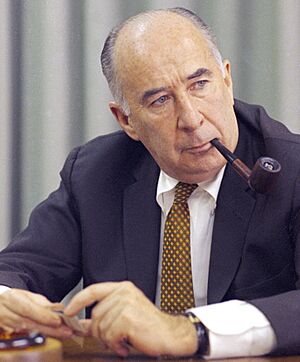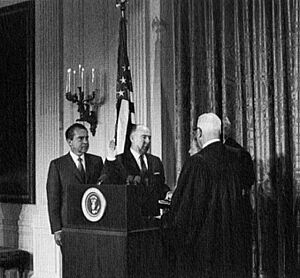John N. Mitchell facts for kids
Quick facts for kids
John Mitchell
|
|
|---|---|
 |
|
| 67th United States Attorney General | |
| In office January 21, 1969 – March 1, 1972 |
|
| President | Richard Nixon |
| Preceded by | Ramsey Clark |
| Succeeded by | Richard Kleindienst |
| Personal details | |
| Born |
John Newton Mitchell
September 15, 1913 Detroit, Michigan, U.S. |
| Died | November 9, 1988 (aged 75) Washington, D.C., U.S. |
| Political party | Republican |
| Spouse | Martha Beall |
| Education | Fordham University (LLB) |
| Known for | Convicted of crimes committed during his tenure as U.S. Attorney General |
| Military service | |
| Branch/service | United States Navy |
| Years of service | 1943–1946 |
| Rank | Lieutenant (junior grade) |
| Battles/wars | World War II |
John Newton Mitchell (September 15, 1913 – November 9, 1988) was an important figure in American politics. He served as the 67th Attorney General of the United States under President Richard Nixon. He also led Nixon's presidential campaigns in 1968 and 1972.
Before his political career, Mitchell was a lawyer specializing in municipal bonds. He later became known for his involvement in the Watergate scandal. After leaving his role as Attorney General, he continued to work on Nixon's 1972 campaign. He faced consequences for his actions during the Watergate affair. As Attorney General, he was known for supporting "law-and-order" policies during a time of many anti-Vietnam War protests.
Contents
John Mitchell's Early Life and Career
Mitchell was born in Detroit, Michigan, and grew up in Queens, New York City. He studied at Fordham University and earned his law degree from Fordham University School of Law in 1938. He also did more studies at St. John's University Law School.
During World War II, Mitchell served in the United States Navy for three years. He was a commander of a PT boat and reached the rank of lieutenant (junior grade). After the war, he worked as a lawyer in New York City until 1969. He became known as a successful lawyer dealing with municipal bonds.
Richard Nixon was a partner at Mitchell's law firm from 1963 to 1968. Mitchell's second wife, Martha Mitchell, became well-known during the Watergate scandal. She often called reporters, claiming that Nixon and his team were trying to blame her husband for the scandal.
Working with New York Government
In the 1960s, Mitchell helped New York Governor Nelson Rockefeller with revenue bonds. He created a special type of bond called a "moral obligation bond." This helped the state get money without needing voters to approve it directly. Mitchell believed this method was a way for leaders to make decisions without always needing public votes.
John Mitchell's Political Journey
In 1967, Mitchell's law firm joined with Richard Nixon's firm. Nixon was planning his return to politics for the 1968 United States Presidential Election. Mitchell had many connections in local government, which made him a key advisor to Nixon. Nixon even called him "the heavyweight."
Leading Nixon's Campaigns
In 1968, John Mitchell became Nixon's presidential campaign manager. He managed the daily tasks of the campaign, which helped Nixon win the election.
Mitchell was also involved in secret efforts to stop the 1968 Paris Peace Accords. These talks could have ended the Vietnam War.
Serving as Attorney General

After Nixon became president in January 1969, he chose Mitchell to be the Attorney General of the United States. Mitchell stayed in this role from 1969 until 1972. He then resigned to manage Nixon's campaign for re-election.
Focusing on Law and Order
Mitchell believed that keeping "law and order" was very important for the government. He thought this sometimes meant limiting certain civil liberties. He supported using wiretaps in national security cases without a court order. He also believed police should be able to hold criminal suspects before trial.
Mitchell brought conspiracy charges against people who protested the Vietnam War. He compared them to groups from Nazi era Germany. He also said the Justice Department was for enforcing laws, not for solving all of society's problems. However, he also told activists to "watch what we do, not what we say."
Helping with School Desegregation
When Nixon first became president, he asked Mitchell to slow down the desegregation of schools in the South. This was part of Nixon's "Southern Strategy" to gain support from white voters in the South. However, federal courts made it clear that segregation was against the law. The executive branch had to enforce these rulings.
Mitchell then began to follow the court orders. He threatened to stop federal money for schools that were still segregated. He also took legal action against them. The Supreme Court had ruled against school segregation in 1954. But it wasn't until 1969 that the Court said there could be no more delays.
Because of these efforts, the number of Black children attending segregated schools dropped a lot. In 1968, about 70% of Black children were in segregated schools. By 1972, this number had fallen to 8%. This was a bigger decrease than during any of the three previous presidents.
Protecting Public Safety and the Environment
Mitchell worked to stop what many Americans saw as threats to safety. These included urban crime, unrest among Black communities, and war protests. He supported ideas like ""no-knock" warrants for police and wiretapping. He also wanted to use federal troops to fight crime in the capital.
Mitchell also played a role in environmental protection. In 1969, the Cuyahoga River caught fire, causing national outrage. President Nixon created the United States Environmental Protection Agency (EPA) in 1970. Mitchell announced that the Justice Department would take legal action against companies polluting rivers. For example, they sued the Jones and Laughlin Steel Company for dumping cyanide into the Cuyahoga River.
Legal Challenges and Later Life

John Mitchell was involved in a legal case concerning a donation to Nixon's campaign. He and Nixon's Finance Committee Chairman, Maurice Stans, were accused of trying to stop an investigation related to a large donation. However, both men were found not guilty in court in 1974.
Mitchell faced serious consequences for his actions in the Watergate affair. He spent time in prison starting in 1977.
Death
John Mitchell passed away on November 9, 1988, from a heart attack in Washington, D.C. He was buried with full military honors at Arlington National Cemetery. This honor was given because of his service in the World War II Navy and his role as Attorney General.
Images for kids



